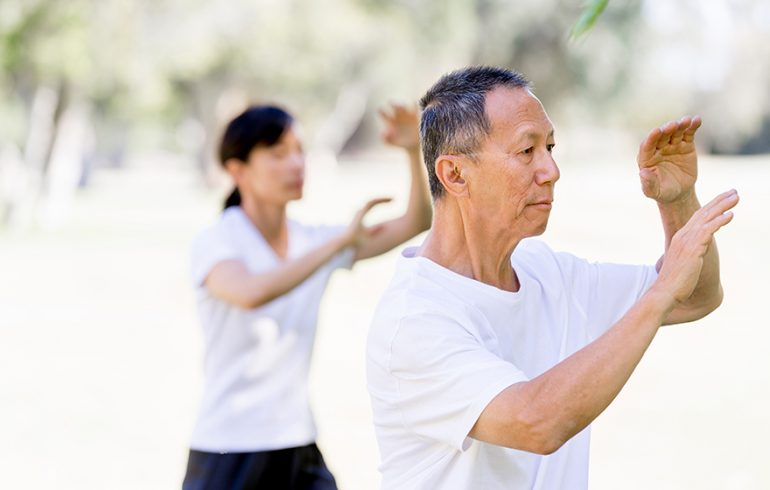Originating as a martial art, tai chi combines mental focus with physical movement. It’s gaining momentum across North America because it rapidly builds balance and strength.

Tai Chi Health Benefits for Beginners
1. Tai chi poses improve breathing and brain activity.
The slow, repetitive and deliberate movements of tai chi are accompanied by breathing exercises, which can improve lung function and oxygen flow. Like other forms of relaxation practices, such as yoga and meditation, long-term tai chi training also benefits cognitive function and concentration in adults.
2. Tai chi improves mindfulness.
Tai chi is a great way to improve your mind-body connection and mental training. Mindfulness and being aware of what our bodies are doing lead to better results from exercise. Focusing our attention on the muscles we’re working also leads to increased muscle contraction.
3. Tai chi relieves symptoms of arthritis.
Tai chi is an effective exercise for older adults with arthritis or other joint conditions. Its gentle movements and poses increase flexibility in the shoulder, hip and knee joints, which in turn help decrease the painful symptoms associated with arthritis.
4. Tai chi rapidly builds balance.
A study published in The New England Journal of Medicine, a peer-reviewed journal, compared the effects of tai chi, resistance training and stretching on Parkinson’s disease patients. Tai chi saw the largest improvement in balance. It also reduced incidences of falls, though not as much as resistance training. In a separate study, more than 700 healthy older adults (mean age 69) took part in a 16-week community-based tai chi program aimed at determining the effectiveness of tai chi in reducing falls and improving balance in people aged 60 and older. Falls were far less frequent in the tai chi group than the control group.
5. Tai chi is a natural therapy for relief from low back pain.
To determine the effect of tai chi exercise on chronic low back pain researchers studied 160 sufferers, ages 18 and 70 years, living in Sydney, Australia. A tai chai training program consisting of 18 40-minute sessions over a 10-week period was administered with positive results. All 160 study participants reported reduced “bothersome back symptoms” and “reduced pain intensity” leading researchers to conclude that tai chi training is a safe and effective intervention for those experiencing chronic low back pain.
The American College of Physicians also recently updated its clinical guidelines for non-invasive low back pain treatments to include tai chi.
How to Start Practicing Tai Chi
Tai chi poses and movements are adaptable to almost any fitness level, from beginners to experienced athletes, including those starting from a chair or wheelchair. Start by looking for classes at your local community center, preferably run by an experienced instructor.
Keep in mind that sets of tai chi poses and movements are called forms. Classes teaching short forms may include a dozen movements, while long forms may include hundreds. Qigong meditation which focuses more on meditation, breath work and repetition, is often associated with tai chi and used as a warm-up routine for tai chi or in combination with tai chi poses.
Trainer’s Tip
The findings about tai chi support what we fitness professionals recommend to our older clients: participate in as many different types of activities as you can to develop well-rounded fitness.



